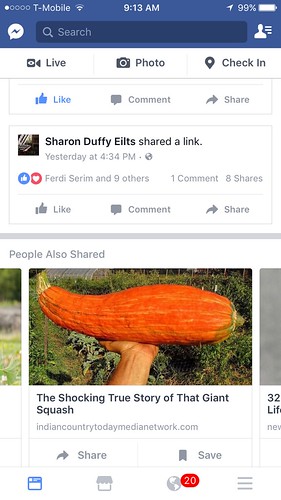Has someone you know shared an article link via email, Facebook, or another social media website that seems too outlandish to be true? Before liking, favoriting, or re-sharing the article link, did you take a few moments to fact-check it by searching online for other sources which either corroborate or refute the article’s claims? If so, congratulations! Your actions in fact-checking links suggest you have some good digital literacy skills. In this post we’ll highlight several useful, online fact-checking strategies and discuss a recent article which can be used with students to highlight this important digital literacy skill.
Digital literacy is important for everyone to cultivate today. Whether young, middle aged or elderly, we all need to sharpen our skills when it comes to determining if something we read online is factual or not. If you’re online and able to share information, you’re also able to share mis-information. Just as we should take responsibility for the things we say in person to others, we also should to take responsibility for the words and links we share online. This is an important element of “digital citizenship.”
Outlandish and far-fetched headlines get people’s attention, and online that means people are likely to click hyperlinks connected to them. The term “clickbait” has been coined to describe online headlines and links specifically designed to lure people into clicking on them by mis-representing facts or promoting outright lies. According to the English WikiPedia:
Clickbait is a pejorative term describing web content that is aimed at generating online advertising revenue, especially at the expense of quality or accuracy, relying on sensationalist headlines or eye-catching thumbnail pictures to attract click-throughs and to encourage forwarding of the material over online social networks. Clickbait headlines typically aim to exploit the “curiosity gap”, providing just enough information to make the reader curious, but not enough to satisfy their curiosity without clicking through to the linked content.
The proliferation of information sources online today continues to blur the lines of journalism and challenge the concept of “trusted voices.” In past generations, news anchors like Walter Cronkite personified the idea of a “trusted news source.” Television news channels from 1947 to 1960 were very limited in number, and in comparison today made up a much simpler media landscape.
Today websites like BuzzFeed challenge the concept of a “news source,” often featuring articles which are considered clickbait by others. Some local as well as national/international news websites now feature “trending articles” which may attract readers but would hardly qualify as “news” by a traditional media outlet like the Associated Press or BBC.
The website Snopes.com claims to be “the definitive Internet reference source for urban legends, folklore, myths, rumors, and misinformation.” When someone emails you or shares a link, story or statistic your critical mind questions, Snopes (@snopes) is a good website to search to see if its authors have verified or debunked the article or story in question.
While trust is essential in our society, it’s also vital that we cultivate a healthy skepticism and willingness to question ideas and “facts” which are presented to us through different types of media. Author Neil Postman, in his excellent 1969 book “Teaching As a Subversive Activity,” calls this the cultivation of “a personal crap detector.” Certainly an election season, like the one in which we find ourselves in the United States, highlights the need for media outlets to help “fact check” the claims of candidates. FactCheck.org (@factcheckdotorg) is one organization dedicated to that specific goal.
"Perceptions of trust help make our society work, but we also need to be suitably skeptical" by @danlevitin #DigCit https://t.co/FxaWRnZKQw
— Wesley Fryer, Ph.D. ??? wesfryer.com/after (@wfryer) September 24, 2016
When you stumble across an article or link you think might be factually dubious, try several Google searches to find articles or websites about the same topic. Use an “iterative search strategy,” in which you use different key words and phrases which relate to the subject of your search. Evaluate the results of your search, and then modify your search strategy (keywords) to improve the results.
Recently, a friend shared a link on Facebook to the article, “Archaeologists Dig Up An 800-Year-Old Native American Pot. What They Found Inside Is Changing History.” To Facebook’s credit, below the article a related link was suggested for another article, “The Shocking True Story of That Giant Squash.” The second, suggested link verified some of the facts from the first, but debunked one of the core claims:
…that dating of the clay vessel indicated that the seeds were more than 800 years old and had been lying dormant since the 13th century.
A Google keyword search for “ancient Indian squash” currently yields a variety of different articles relating to this specific story. Out of the first 10 Google search results, several include the “800 year old clay vessel” claim, while others refute or question it.
Some of the domain names of these websites are mainstream media sources which should be familiar (NPR from 23 June 2016 and The Chicago Tribune from 22 June 2014) while others are not and therefore deserve further scrutiny and analysis (Mother Nature Network from 1 Oct 2015 and Off The Grid News from 6 October 2015).
Consider using this news topic and article search with your own students to discuss the digital literacy strategies and lessons which can be employed and gleaned from it. Here are some guiding questions to consider using. Ask your students to brainstorm and suggest others:
- What makes an online source more credible or believable?
- Why is it important to fact-check news articles which seem outlandish or hard to believe?
- Is it ethical for a news website to share information in a headline which is false?
- Do website owners have an ethical obligation to change their headlines if they later learn information is false?
- Do “regular people” have any obligations when it comes to checking facts before sharing information or links online?
- How could you promote more fact checking among your friends and peers?
If you use any of the ideas from this post with your own students, please let me know by sharing a reply on Twitter to @wfryer or with a comment on this post below. We all can play important roles in promoting digital literacy among those people who we interact and share ideas with both in-person and online!
If you enjoyed this post and found it useful, subscribe to Wes’ free newsletter. Check out Wes’ video tutorial library, “Playing with Media.” Information about more ways to learn with Dr. Wesley Fryer are available on wesfryer.com/after.
On this day..
- Four Upcoming iPad Digital Storytelling Workshops in Oklahoma – 2013
- Oklahoma Innovation Task Force Education Survey – 2013
- Common Core Writing Lesson With AudioBoo: 9/11 Narrated Art – 2012
- A Google Geo-Teacher Learning Day Story: In Tweets – 2011
- Google Earth and Google Maps GTI Workshop (Sep 2011) – 2011
- Google Fusion Tables: Geo-spatially connecting database data – 2011
- Visualizing Data in Google Earth – 2011
- Digital Grounding and loss of Facebook Privileges – 2010
- Follow tonight’s Presidential debate on OETA’s Political Pulse Blog – 2008
- CamTwist worked today for our webcast! – 2008



Comments
6 responses to “Digital Literacy Tips: Strategies for Online Fact Checking”
In many of these cases, it’s actually okay to click on the link and go directly to the source. Look for an “about” page or tab. One of the latest trends in clickbaiting is to develop a “newsletter” as a source of Fantasy news. For example, “Brad Pitt is moving to Oklahoma,” according to the Landrypost.com. It states clearly that it is “an entertainment website composed of fantasy news and satire. Though some articles may contain actual events, none of the articles on Landrypost.com should be considered true and are simply meant for entertainment purposes.”
Kind of makes one’s head spin…
Great article! I’m glad you mentioned clickbait. I find them so insidious because they are most often found on reputable news sites masquerading as real news. Facebook actually has an algorithm to weed out clickbait by analyzing the headlines, and determining how misleading, or exaggerated they are. “The Shocking True Story of That Giant Squash” is exactly the kind of headline that should have been filtered out, but I guess it just fell through the cracks.
Although we have been flooded with misinformation in this election season, perhaps more so than in previous years, I am glad that it has helped focus attention on the importance of fact-checking. Fact-checks are in fact events of their own—I find the live fact-checks on Politifact.com more entertaining than the presidential debate itself. Jane Elizabeth, who was a journalism professor at Old Dominion University, gave her students an exercise to test their fact-checking skills. She gave them a news story and asked them to identify parts that they would fact check. I thought that was an interesting exercise that could be adapted for the classroom as well.
Great article! I’m glad you mentioned clickbait. I find them so insidious because they are most often found on reputable news sites masquerading as real news. Facebook actually has an algorithm to weed out clickbait by analyzing the headlines, and determining how misleading, or exaggerated they are. “The Shocking True Story of That Giant Squash” is exactly the kind of headline that should have been filtered out, but I guess the system is not perfect yet.
As a teacher, I’m finding it more and more necessary to not only use resources such as Snopes.org or Factcheck.com for myself, but also teach my students how to use these resources. It is essential to educate our students on internet validity and how important it is not to believe everything that is read and presented as truth. We joke sometimes by saying, “I read it on the internet, it has to be true.” This is obviously a joke because everything we read is not true, but we must teach our students how to decipher between what is true and what is false. I think the earlier students are intentionally instructed on “digital citizenship” and their role as researchers, the better they will be at gathering valuable information for research projects, evidence to support opinions, etc. Students are being exposed at a very early age to so many different ways to access information, so it is imperative for them to be able to sort through the information to find what is truth.
Excellent Article! I had never heard of some of this terminology. I currently teach 4th grade and am always questioning how reliable sources and information are on the internet. I am attempting to teach my students how to check the liability of sources and check their facts when researching on-line. Currently this is posing as a struggle for me. I too find myself becoming a victim of following clickbait. Especially that on Facebook. Something looks interesting and appealing to me, then I follow it to read more. I need to be reminded of fact-checking often and be sure that I am teaching my students to do the same each and every time they read something.
I really enjoyed your article. I think it’s so important to remind students that posting and sharing information online comes with a certain degree of responsibility that should not be taken lightly. If we can help them see that they are really acting as publishers whenever they post something, I think they might be encouraged to take a bit more time to ensure the quality of their work.